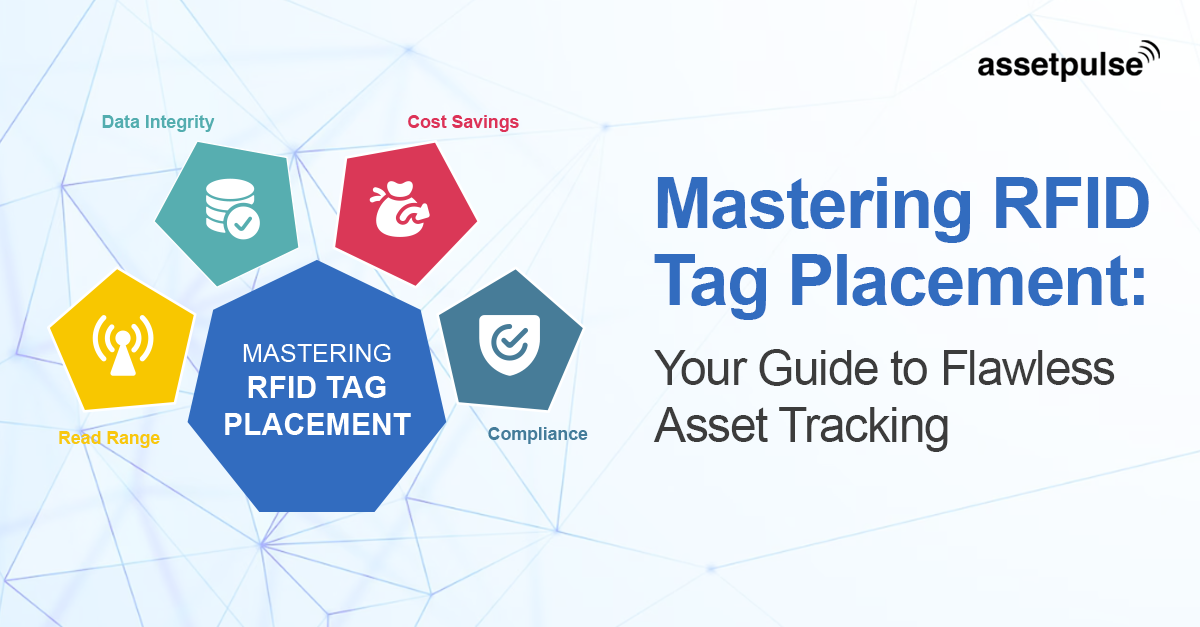Every enterprise has faced it: critical assets go missing, inventory counts drag on for days, and audit trails come up short. Often, the culprit isn’t the technology—it’s where the RFID tags live. RFID tag placement might sound simple, but subtle mistakes can derail your entire asset tracking system.
In this guide, you’ll learn what RFID tag placement is, why it matters, and how to nail optimal positioning, whether you’re tagging lab equipment, warehouse pallets, or datacenter servers.
Ready to master RFID tag placement and maximize your ROI?
Discover proven tag positioning strategies from RFID Solution Experts!
Get Free ConsultationWhat is RFID Tag Placement?
At its core, RFID tag placement refers to the physical location and orientation of an RFID tag on an asset. Placement covers:
- Positioning on the asset’s surface (edge, center, underside)
- Orientation relative to the RFID antenna’s read zone
- Environment—metal, liquid, or high-interference areas
Getting the placement right ensures each tag reliably catches the reader’s signal, delivering accurate real-time inventory visibility and seamless cycle counts.
Why Tag Placement Matters
RFID systems depend not just on tag type and reader quality, but also on where and how the tag is placed.
- Maximized Read Range & Accuracy
A correctly oriented tag might read from 30+ feet away; a poorly placed tag may not read at all. Proper RFID tag positioning boosts detection rates and eliminates “ghost reads.” - Consistent Data Integrity
Inconsistent reads lead to phantom assets or missing records. With optimal tag mounting, you minimize false negatives and maintain a single source of truth. - Cost Savings & Labor Efficiency
Less rework, fewer manual scans, and faster audits translate into lower labor costs and higher ROI for your RFID investment. - Enhanced Compliance & Security
In regulated industries like pharmaceuticals or medical devices, accurate tracking is non-negotiable. Proper placement supports audit trails, change-control, and recall readiness.
Risks of Incorrect RFID Tag Placement
- Signal Shielding by Metal & Liquid
Metal surfaces and liquids absorb or reflect radio waves, causing dead zones. Tags stuck flat on a steel cabinet often go unread. - Antenna Coverage Gaps
If tags face away from the reader’s antenna beam, read rates plummet. Imagine warehouse pallets tagged on the wrong side; forklift operators will curse every missed scan. - Increased Interference
Placing multiple tags too close together can cause signal collisions. Without proper tag separation guidelines, you invite cross-reads and data clutter. - Premature Tag Failure
Tags mounted near moving parts or in high-vibration zones may peel off or break, interrupting your real-time location system (RTLS) insights.
Want to boost read accuracy through smarter tag positioning?
Learn optimal tag placement strategies from the experts!
Get Free ConsultationBenefits of Optimal RFID Tag Placement
Optimal tag placement maximizes accuracy, improves reliability, and ensures faster scans in real-world environments.
- Higher Read Reliability
Consistent tag reads (95%+ success rates) even in challenging environments. - Streamlined Workflows
Hands-free, one-pass scans cut cycle-count times by up to 80%. - Superior Asset Utilization
Real-time dashboards empower you to identify idle assets and redeploy them where they’re needed most. - Scalable Deployments
With tag placement best practices in place, rolling out RFID across new sites or asset classes becomes plug-and-play.
Factors to Consider for Correct Tag Placement
- Material Composition
- Metal Assets: Use spacers or foam backing, or choose on-metal RFID tags designed especially for metal surfaces.
- Liquid-Filled Containers: Place tags away from liquid volume; consider “flag tags” that extend above the liquid line.
- Tag Orientation & Read Zone
- Align the tag’s long axis perpendicular to the antenna’s beam for maximal coupling.
- Test multiple angles—especially on curved surfaces like drums or cylinders.
- Environmental Conditions
- Temperature Extremes: Select tags rated for freeze-thaw cycles or high-heat sterilization.
- Vibration & Impact: Mount tags in recessed areas or protective housings to prevent wear.
- Antenna & Reader Placement
- Map out antenna coverage zones and overlap fields to avoid blind spots.
- Verify read patterns using handheld readers prior to deploying fixed readers.
- Spacing & Tag Density
- Maintain a minimum gap (often 2–3 inches) between tags to prevent signal interference.
- In dense tag environments (e.g., bin locations), stagger placement at varied heights.
- Motion Consideration
- In moving environments (e.g., conveyor belts), tags should be placed where read duration is maximized within the reader’s zone.
- Tag Size and Gain
- Larger tags = better range = more flexible placement. Low-gain tags require more accurate placement.
Want to slash your audit times with the right tag placement?
Get actionable insights that prevent tracking failures!
Get Free ConsultationIndustry Use Cases for RFID Tag Placement
- Laboratories & Research Facilities
Challenge: Tracking thousands of pipettes, samples, and freezers.
Placement Best Practice:- Use flag tags on pipettes so the tag extends above trays.
- Mount freezer tags on side panels with foam spacers to avoid ice build-up interference.
- Manufacturing Plants
Challenge: Monitoring tools, molds, and work-in-progress (WIP) parts.
Placement Best Practice:- Embed tags in tool handles or protective sleeves.
- For WIP carts, place tags on the cart’s top edge, ensuring unobstructed reads in automated gateways.
- Warehouses & Distribution Centers
Challenge: One-scan aisle passing of fully loaded pallets.
Placement Best Practice:- Place tags on two adjacent corners of the pallet, one at the front and one on the side, to ensure read redundancy.
- Use pallet-rated tags with reinforced adhesives to withstand outdoor staging.
- Data Centers
Challenge: Asset audits of racks, servers, and backup drives.
Placement Best Practice:- Place tags on rack rails near the front to align with handheld readers.
- Use compact, heat-resistant labels on the bezels of hot-swap drives.
- Medical Device Manufacturing
Challenge: Regulatory compliance and batch tracking.
Placement Best Practice:- Apply tags on finished device packaging, away from metal tooling and machinery.
- Use sterile-packaged RFID tags inside process chambers to track sterile loads.
How to Validate Your RFID Tag Placement
- Pilot Testing
Run a small-scale proof-of-concept, testing various tag positions and recording read rates. - Read-Rate Heat Mapping
Walk the space with a handheld reader to generate a visual map of strong and weak zones. - Iterative Adjustments
Tweak placement based on heat maps—move tags, adjust antenna tilt, or add foam backers. - Ongoing Monitoring
Integrate tag health checks into your dashboard to flag low-read tags and schedule physical inspections.
Next Steps
RFID is only as powerful as its weakest link—and tag placement is often that link. By understanding material impacts, orienting tags to your antenna geometry, and validating placements with heat maps, you’ll unlock the full potential of real-time asset tracking.
Ready to optimize your RFID deployments?
Schedule a free consultation with AssetPulse and let our experts tailor a placement strategy for your lab, warehouse, or data center.
With the right placement, you’ll see fewer missed reads, faster audits, and an asset tracking system you can trust.
FAQs
1.What is RFID tag placement and why is it important?
RFID tag placement is the positioning and orientation of a tag on an asset. It’s crucial because proper placement ensures reliable signal capture, maximizes read range and accuracy, and maintains consistent data integrity.
2.Where is the best place to put the RFID tag?
The best placement depends on material composition and environment. Avoid direct contact with liquids, ensure tags face the antenna’s read zone, and position them away from high-vibration areas or moving parts.
3.How does RFID tag placement affect read accuracy and tracking efficiency?
Correct placement can achieve 95%+ read success rates and enable reads from 30+ feet away, while poor placement may prevent reading entirely. Optimal placement cuts cycle-count times by up to 80% through streamlined workflows.
4.Where should RFID tags be placed on products for optimal performance?
Placement is entirely dependent on the material the product is made of. If the tag is suited for the product material, tags should be placed where read duration is maximized within the reader’s zone.
5.Can placing RFID tags near other tags or electronic devices cause interference?
Maintaining proper spacing (2-3 inches minimum) and staggering placement at varied heights prevents interference in dense tag environments.
6.How accurate is RFID tag positioning?
With optimal placement, RFID systems can achieve read reliability rates of 95% or higher. Accuracy depends on proper orientation, material considerations, environmental factors, and validation through pilot testing and read-rate heat mapping.
7.How to validate or test RFID tag placement?
Validate RFID tag placement by pilot testing various positions, using handheld readers to perform read-rate heat mapping, and making iterative adjustments based on data.
8.What industries or asset types most benefit from optimized RFID tag placement?
Industries like manufacturing, healthcare, laboratories, warehousing, and data centers benefit most. Asset types include work-in-progress parts, medical devices, lab equipment and samples, pallets, servers, and sensitive equipment where accuracy and compliance are critical.




